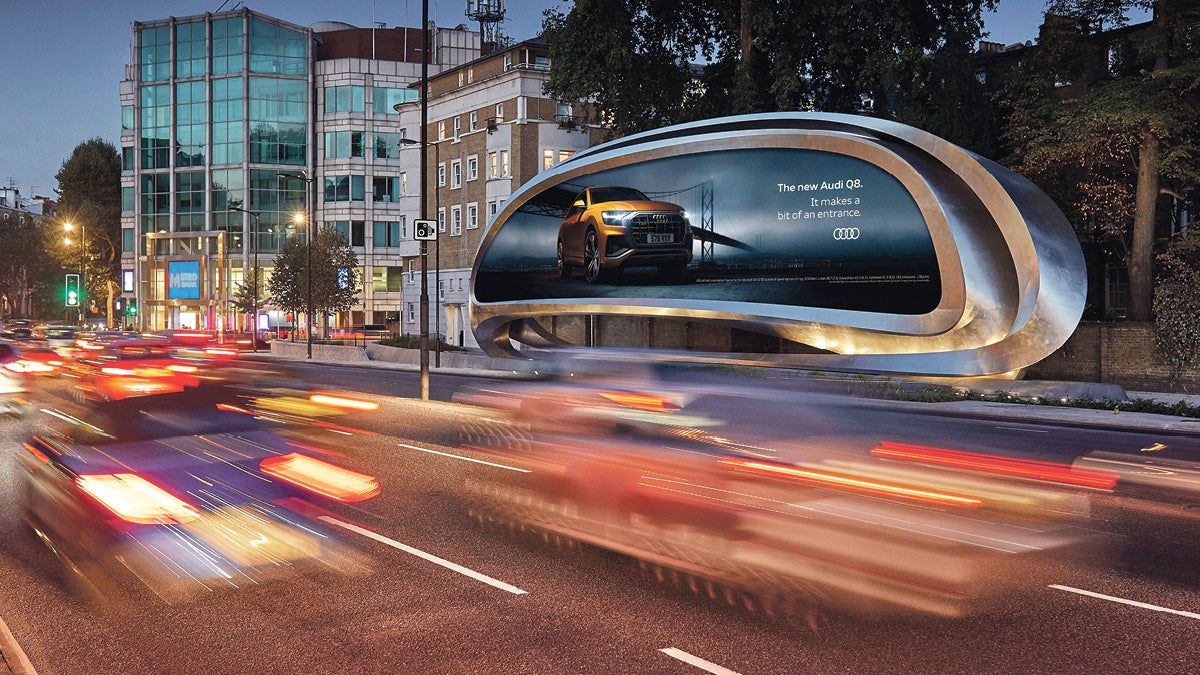Rajvi Kantaria joined JCDecaux UK three months ago as director of marketing after 15 years working client-side for a variety of brands ranging from American Express to Speedo. Although she knew JCDecaux was the UK’s leading out-of-home (OOH) media company, she wasn’t aware of the newest capabilities of the medium and its role in the media mix. With spending on OOH expected to outstrip the combined total for newspapers and magazines by 2024, and digital out-of-home (DOOH) now accounting for half of spend on OOH, Rajvi explains what she has learnt about why OOH is different and why the oldest medium in the world continues to deliver for brands in a digital age.
OOH can be targeted with the same precision as digital advertising
As someone who loves their morning coffee, a recent Costa Coffee OOH campaign was one of the first to catch my attention.
In the morning you’d see an ad in the station on your way to work that said “This will make you a morning person” with a picture of a flat white, and then while out shopping at Westfield at lunchtime, the message changed to “Westfield is hungry” with a picture of a meal deal… perfect!
When I first started managing multi-channel campaigns over a decade ago, we only had static billboards. For anyone who’s been in the industry that amount of time, you’ll relate to the change in language. We used to talk about buying frames, then later we talked about impressions, now you can layer moment and mindset onto both those things to target OOH to the mood of the audience, and then adapt your messages accordingly. If you think about how you feel as you’re commuting through the station on your way to work, for example, versus browsing in duty free at an airport before a holiday or hitting the shopping centre on a weekend; the way you think and feel is quite different in each environment.
Understanding and applying frame of mind can really help inform the brief you give to your creative agency on formats and does impact on results.
If you need something more targeted to a more specific audience, you can also go so far as to use the same targeting models you’ve created for digital, using the data from your DSP (demand side platform) to target, optimise and measure OOH. It means a campaign only runs when the specified audience is available and you can co-ordinate your digital and OOH campaigns.
The right choice depends on each brand’s campaign objectives and we can chat through all the options with you to find the best fit for your plan. We have lots of information and data on these areas to help people target better, create an impact and improve results.
OOH makes your digital campaign work harder
As marketers we try to aim for integrated, 360° campaigns and ensure that our messages are consistent across multiple channels. We are now actually able to measure this, including gauging how OOH specifically complements mobile.
We call it the two-screen future, giving brands the best of both worlds.
Serving out-of-home in a contextual way creates emotional connections
Facebook carried out some recent research that showed how OOH acts as a primer for online campaigns. Ad engagement on social media after exposure to a DOOH ad increased by 13 per cent. In other words, brands’ Facebook campaigns will work much harder if the audience has seen an outdoor ad first.
We would love to test this further with live case studies and we are continually working with clients on collaborative research in this space.
Virgin Gyms is a great example to bring this to life. The brand recently activated DOOH screens near gyms on Mondays, traditionally highly motivational days for exercise, and ran the same ads across mobile. Seven million DOOH impressions and five million mobile impressions drove a 23 per cent increase in walk-ins.
Our teams would be delighted to chat to marketers about how they can make this approach work for their brands too.
Context fuels creativity: forging an emotional connection
As a client, I would have loved to have seen neuroscience research showing how I could supercharge my campaigns. This makes the new The Moments of Truth insight super interesting. It is a joint piece of research from Clear Channel, JCDecaux UK and Posterscope that measures brain activity to show how serving outdoor advertising with context creates emotional connections to the brand, whether by location, time, weather or behaviour.
There is a real science behind DOOH that we can share. Context matters and if you can incorporate that into your creative, you will drive results at every level of the marketing funnel.
Take Cadbury, which used specific store-level till data to tempt customers into trying a different chocolate bar rather than defaulting to the usual choice. The campaign achieved really impressive results. Or look at the Starbucks campaign that ran near their stores, changing the message according to the weather, such as “It’s raining we’re pouring!”. Or the Aussie ad for anti-frizz haircare that only played on rainy or humid days; I’m sure we can all relate to a bad hair day.
Serving OOH in a contextual way creates emotional connections, empowering brands to engage consumers on a deeper level. Come and chat to us to get the full results on the neuroscience research. We are happy to share and talk through how this could work for you.
Measuring OOH’s role throughout the entire marketing funnel
Achieving a balance between branding and activation was something I was always interested in as a client. But I wasn’t familiar with Work Research’s Brand Gap report that looks at the imbalance between brand and activation. I’d encourage everyone to read it or to invite our team to share how other brands are bridging this gap.
Marketers have always thought of OOH as a go-to brand-building channel and we also know it drives conversion at point of sale. Yet we can now see how OOH can complement other channels to help drive all parts of the funnel and help to plug the so-called “consideration gap”, the imbalance between the budget invested in activation and that invested in brand awareness. Brands have long been focusing too much on the short-term at the expense of the long view and now we know how we can help.
Out-of-home complements mobile, making digital campaigns work harder
Any part of your campaign can be amplified by OOH, whether your objectives are brand awareness, consideration or activation and we can work with you to measure that with our test-and-learn capabilities.
Brand Gap research shows more than half of brands say they are planning to do something different with their media spend, while nearly half plan to move money into channels that deliver branding and activation.
It’s so encouraging that change is happening and the importance of brand advertising in every part of the funnel is now being recognised. Return on investment is a perennially hot topic in marketing and I had never realised that the impact of OOH can now be measured throughout the funnel. It opens up so many more opportunities for brands and if you’re looking to do something different, please do get in touch and we’ll see how we can help.
OOH taps into the power of the shared public experience
 Two things have struck me about OOH since joining JCDecaux UK. The first is that there really is nothing quite like the shared experience that OOH brings. The ability to share a moment or a mindset in public is why the medium captures the spirit of the nation so well during big events from Wimbledon to the Six Nations or the Olympics and it is why it complements the private mobile screen so well.
Two things have struck me about OOH since joining JCDecaux UK. The first is that there really is nothing quite like the shared experience that OOH brings. The ability to share a moment or a mindset in public is why the medium captures the spirit of the nation so well during big events from Wimbledon to the Six Nations or the Olympics and it is why it complements the private mobile screen so well.
If we think about how 192,000 people in the UK stayed up to watch the series finale of Game of Thrones live at 2am when it aired last year. Rather than downloading it and watching it alone, there is huge power in the shared experience and in watching something dramatic unfold at the same moment as millions of other people. In much the same way, a brilliant OOH campaign created a shared experience for fans, proclaiming “Sayon Arya”, “Cersei ya later” and “Ta-ra Garyen”.
Secondly, OOH is a public-facing and public-spirited medium. Advertising funds bus shelters and public amenities, thanks to income invested by cities and transport partners UK-wide. In addition,100 per cent of JCDecaux UK’s energy is from green sources, so it is hugely inspiring to find we are one of only a small number of companies to be listed on the prestigious CDP A List for climate change, which recognises organisations for their contribution towards developing the low-carbon economy.
OOH gives brands a public voice to take a stand. In a world of fragmented media and echo chambers, OOH stands out with its ability to simply be heard. It also offers a greater degree of control, enabling brands to pinpoint exactly where their ads will appear, which isn’t always possible with digital marketing.
Take Bupa’s Is it normal? mental health awareness campaign in January 2020, which included powerful OOH activations across iconic DOOH locations UK-wide. Its impact was intensified by its public reach and it showed how the impact of a message can be accentuated by a collective experience.
This collective power heightens emotion and, in turn, creates a platform for brands to take a stand and ensure their message is loud and clear.
Making the most of your media spend
Finally, I’ve seen there is a real desire at JCDecaux UK to help clients make the most of their media spend. As a family-run company, the values really come through in the organisation’s culture: they care about making things better for the next generation and want to share their knowledge and collaborate more to create research projects that will really make a difference in the future. All our customers can take advantage of the huge knowledge base that exists in OOH.
At JCDecaux UK we want to help brands and their agencies make the most of their media spend. We’d love to share ideas, collaborate and, importantly, make a difference.
 Book a coffee with Rajvi
Book a coffee with Rajvi
If you’d like to discuss how JCDecaux UK can help you make the most of your media spend, then please drop me a line for a catch up.
uk.coffeewithrajvi@jcdecaux.com
OOH can be targeted with the same precision as digital advertising


